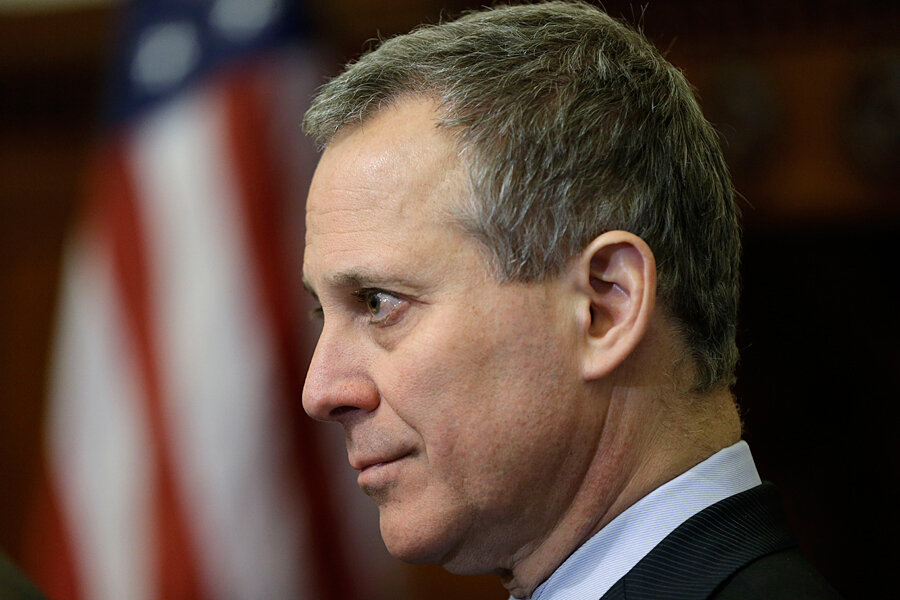Stop-and-frisk: New York AG report questions its effectiveness
Loading...
| New York
The political and legal maelstrom surrounding the controversial stop-and-frisk policy was given renewed vigor this week as the state’s attorney general issued a report questioning how effective the tactic has been.
The report, released Thursday by New York Attorney General Eric Schneiderman (D), found that only 3 percent of the some 2.4 million New Yorkers stopped between 2009 and 2012 – most of them black and Latino men – ended in a guilty plea or conviction at trial. And of these, just one in ten had a sentence of 30 days or more.
The attorney general also investigated the racial disparities in the pleas or convictions that resulted from arrests for marijuana possession – a significant portion of stop-and-frisk arrests. Police arrested over 10,500 blacks for possessing the drug, and about 5,600 Hispanics, but less than 2,000 whites. The court dismissed about 75 percent of these cases with white defendants, however, while only dismissing about half of those with black defendants and about 60 percent of Hispanics.
The report echoed many of the findings of Judge Shira Scheindlin, who ruled in August that the NYPD’s tactics amounted to “indirect racial profiling” as well as unchecked searches that violated the Constitution. The ruling was a blow to Mayor Michael Bloomberg’s legacy on crime, which has remained at historic lows throughout his tenure, and he has been visibly angry in attacking both the judge and her findings.
Since Judge Scheindlin’s ruling, however, critics of the bitterly contested police policy have been reeling. A federal appeals panel shocked legal professionals when it took the unusual step to rule, without a formal complaint or hearing, that Judge Scheindlin “ran afoul” of judicial codes of conduct back in 2007, when she improperly steered the now-famous case to her courtroom through a “related-case” rule.
The appeals panel also put on hold her constitutional findings, as well as the remedies she ordered, including the appointment of an independent monitor to oversee changes in the NYPD’s stop-and-frisk policy. Police have since resumed stop-and-frisk searches as the decision heads toward appeal.
The release of Mr. Schneiderman’s report enters the wake of another unusual legal battle – one pointing to the enormous political stakes surrounding stop-and-frisk.
On Wednesday, the appeals court appeared to backtrack from its ruling, after legal circles around the country have been abuzz with the implications of the court’s rare move. Indeed, though it denied another unusual motion by Scheindlin – who also made an unprecedented legal request to be reinstated – the court changed its tone dramatically, saying the federal district court judge was “a long-serving and distinguished jurist” and emphasized that it had made “no findings of misconduct, actual bias, or actual partiality.” It was simply the “appearance” of partiality they objected to, and thus removed her from the case.
“It was really quite extraordinary, and that’s the word in legal circles,” says James Cohen, professor at Fordham University’s School of Law in New York. “This is an example of a very conservative panel – and it is known to be a conservative panel – that reached out and in quite an unprecedented fashion, slapped the district court’s face.”
There was something unusual about the timing of Thursday’s report from the attorney general, as well. It was not a part of an investigation, nor was it an attempt to issue any legal recommendations to the New York Police Department. It was meant to “advance the discussion,” according to the report.
“My office's analysis of the city's stop-and-frisk practices has broad implications for law enforcement, both in New York City and across the state,” Schneiderman said in a statement. “It’s our hope that this report – the first of its kind – will advance the discussion about how to fight crime without overburdening our institutions or violating equal justice under the law.”
The NYPD’s spokesman, John McCarthy, told the Associated Press Thursday that the attorney general’s analysis was flawed, saying it ignored situations in which stop-and-frisk actions prevented crimes from happening, and in which there would be no arrest.
So the issue promises to spill over into the incoming administration of Mayor-elect Bill de Blasio, whose outspoken opposition to the policy was a major factor in his stunning landslide win last week. He has promised to drop the city’s current’ appeal of Scheindlin’s ruling – which would not be decided until well into next year – and modify, though not end, the stop-and-frisk procedures.
Still, the Bloomberg administration, with an eye toward removing the mark on its crime-fighting legacy, rushed to ask the appeals panel to vacate Scheindlin's ruling last week, arguing her “misconduct” during the trial clouds all of her subsequent findings.
And the city’s police unions, too, asked the court last week to allow them to join the appeal should the de Blasio administration drop it, as is expected. The action sets the stage for a bitter confrontation between the new mayor and the NYPD, and promises to keep stop-and-frisk as an ongoing issue.
Scheindlin’s rulings, "if left undisturbed, would unfairly taint the integrity of the 35,000 members of the New York City Police Department and would re-write the rules governing how they conduct themselves on a day-to-day basis,” union lawyers wrote in court papers filed last week.








